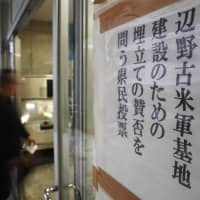On Sunday, Okinawa Prefecture's 41 cities, towns and villages held a referendum on whether to relocate U.S. Marine Corps Air Station Futenma from Ginowan, in the central part of the main island, to a replacement facility being built beside Camp Schwab off the coast of Henoko. It was the first prefecture-wide referendum on the contentious issue. Here, we take a look at the major questions surrounding Sunday's vote.
Why a referendum?
Because, more than 20 years after the United States and Japan agreed to relocate the air base to the Henoko area, the facility has yet to be completed.
During that time, opposition by Okinawan anti-base activists, politicians, bureaucrats, and business leaders has stalled completion even as Tokyo and Washington continue to insist there is no other viable alternative but Henoko.
Things changed in December 2013, when then-Gov. Hirokazu Nakaima met with Prime Minister Shinzo Abe and approved the Henoko plan. In return, Abe promised Okinawa at least ¥300 billion annually until the end of fiscal 2021 as money for local development. Nakaima also demanded Futenma be closed within five years and raised the topic of revising the U.S.-Japan Status of Forces Agreement to give Okinawa more authority to question U.S. service members suspected of crimes.
But Okinawan anger over Nakaima's deal led to his defeat in the 2014 gubernatorial election by Takeshi Onaga, who vowed that no new bases would be built. When Onaga died in August 2018, his successor, Denny Tamaki, also vowed to oppose the Henoko relocation plan. In December, the central government began landfill work for the project. This prompted Tamaki and his supporters to hold a referendum, which they hoped would settle the issue.
What were Okinawans voting for?
The referendum on whether to move the Futenma base to Henoko gave voters three choices: agree, oppose or neither.
An estimated 1.16 million Okinawans 18 years or older were eligible to vote.
The choice made by at least a quarter of those who take part in the referendum must be respected by the governor, and reported to the Japanese government and the president of the United States. A Kyodo poll of eligible voters last week showed 67 percent planned to vote against the Henoko plan.
However, the referendum is not legally binding, and the central government said it will continue building the replacement facility at regardless of the outcome.
If the referendum is not legally binding, what's the point?
The result could have political ramifications, depending on the final turnout and which choice gets the most votes.
A high turnout rate combined with a high percentage of no votes will likely embolden the anti-Henoko governor and the Okinawa Prefectural Assembly. That could lead to further lawsuits by Okinawa challenging construction. The prefecture could also move more aggressively to delay or deny any local approval needed for central government requests related to the Henoko facility.
On the other hand, a low turnout rate, or a higher than expected percentage of yes votes, could weaken Tamaki and the anti-base movement and embolden the central government.
A mixed result, with many residents voting "neither," is likely to be seen by the central government as a rejection of the anti-base position, but unlikely to convince Okinawa's anti-base movement to give up its struggle — meaning the confrontation between Okinawa and Tokyo over the issue will continue.



